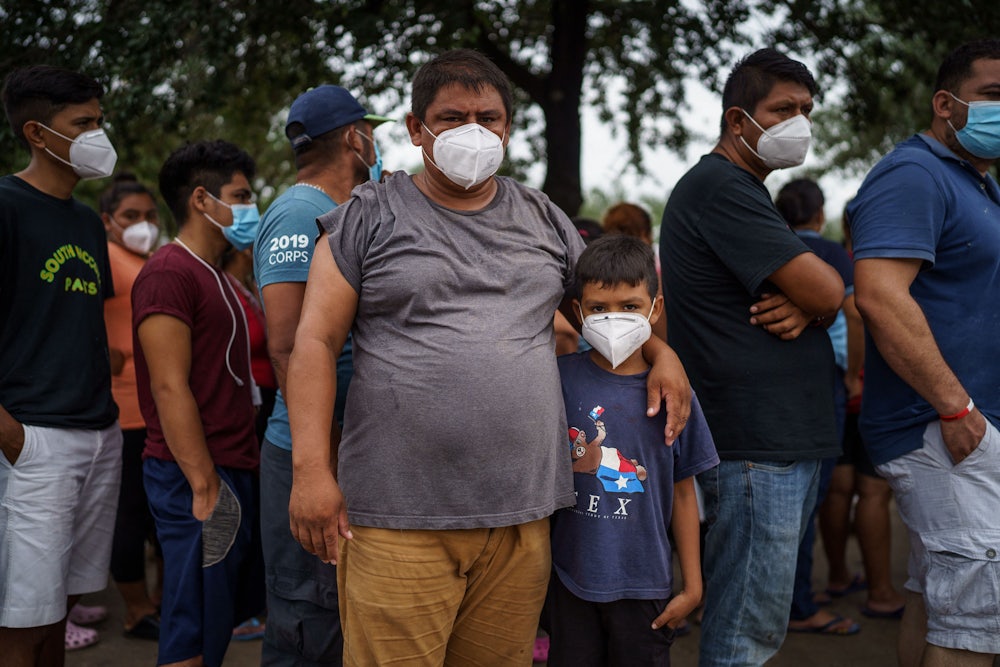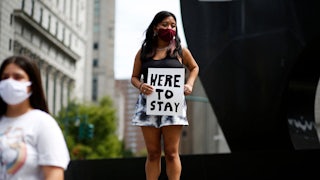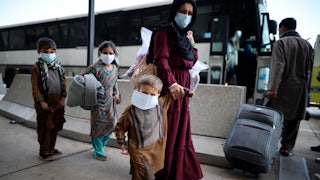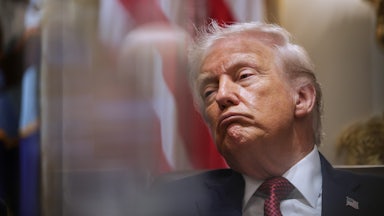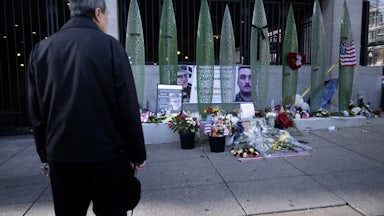In an August 6, 2020, speech to the National Association of Latino Elected Officials, less than two weeks before being officially designated as his party’s presidential nominee, then-candidate Joe Biden said his administration would “restore our moral standing in the world and our historic role as a safe haven for refugees and asylum-seekers, and those fleeing violence and persecution.”
Just under 18 months later, on February 4, Biden’s Centers for Disease Control and Prevention chose to prolong once again a Trump-era order that undoubtedly is the most restrictive anti-asylum policy in American history. Based on a strained reading of Title 42, a long-standing federal law meant to protect the United States from communicable diseases from other countries, the order has been used throughout the Covid-19 pandemic to expel migrants arriving at U.S. borders immediately, regardless of whether they intended to present asylum claims.
Biden, like Trump before him, is not invoking Title 42 for public health purposes; the U.S. government is entirely capable of accommodating asylum-seekers amid the pandemic. Rather, the president doesn’t want to give up an extremely effective tool to shut down asylum once the political heat gets too intense. He’s clearly petrified at the perception that he’s an open-borders president, while failing to understand that his political opponents will push this narrative regardless of what he does.
The impact of this policy is obscene. The order incentivizes migrants to avoid capture instead of simply turning themselves in to Border Patrol agents, as would-be asylum-seekers have often done, leading to spikes in death and suffering as migrants attempt crossings in less hospitable areas. Thousands of Haitians who were camped out near the town of Del Rio, Texas, and infamously chased by horse-mounted Border Patrol agents, were subsequently expelled under Title 42—back to an unstable country of origin where most hadn’t been in years.
This would already be a very high price to pay in exchange for protecting the public from disease, but no actual epidemiologist or public health expert seems to believe that the order accomplishes this. Former Vice President Mike Pence reportedly overruled CDC career staff who objected to the order, and directly strong-armed former CDC Director Robert Redfield into issuing it. The government has never presented any evidence that the order has measurably impacted transmission in the country.
In effect, Covid-19 was a convenient excuse to enact a border restriction that the Trump administration wanted anyway; and if Covid was an excuse, there’s no reason to think it’ll be the only one or that this application of Title 42 will go away as the coronavirus becomes endemic. There’s a very real possibility that it will simply become another tool in the immigration-restrictionist toolbox, latching onto the disease of concern du jour, a point driven home by the fact that Trump’s anti-immigration architect Stephen Miller reportedly tried to implement the order several times before Covid-19 struck, including after a 2019 mumps outbreak in Immigration and Customs Enforcement detention.
“It’s an emergency power. And in a sense, what you worry about is that it becomes a chronic emergency, an emergency that never ends,” said Dr. Chris Beyrer, a professor of public health and human rights at Johns Hopkins University and a longtime critic of Title 42. “This is the third coronavirus to emerge and become a new human pathogen. First SARS, then MERS, then Covid-19. This happens to be far and away the most infectious and far and away led to the greatest loss of life, but there are plenty of other coronaviruses out there. And, of course, there are many other pathogens.”
Beyrer pointed to a document known as the Siracusa Principles, drafted by the International Commission of Jurists in 1984, which sets forth a series of standards for states of emergency, including public health emergencies, to be used by governments to limit rights and freedoms without running afoul of human rights. Among these is the maxim that limitations on rights won’t be applied in an arbitrary manner and will be proportional to a legitimate pressing public or social need. He believes that the order fails these tests, refusing to follow examples of effective disease control during humanitarian migration that already exist and have proven effective. “We have for a very long time had an active [tuberculosis] screening and TB treatment program for refugees and asylum-seekers in refugee camps all over the world,” he said.
Aaron Reichlin-Melnick, policy counsel at the American Immigration Council, pointed to an entirely separate proposed regulation issued by the Trump administration in August 2020—which would have classified people who had so much as traveled through a country with significant Covid-19 spread as “a danger to the security of the United States” and categorically barred them from asylum eligibility—as further evidence that Miller saw the pandemic as an opportunity to throw restrictions at a wall to see what would stick. “Someone who had already been in the United States for five years could theoretically be banned from asylum because, when they entered the country, they were entering from a country that had a communicable disease in it, showing in many ways the extent to which these regulations and policies are unmoored from public health concerns,” he said.
One of Title 42’s most pernicious and long-lasting potential impacts might not even have a cursory nexus to public health. In court, the administration has never really disputed the fact that the restrictions plainly violate another part of U.S. law: Title 8, otherwise known as the Immigration and Nationality Act, the statutory framework that governs the whole of U.S. immigration, from work visas to the immigration courts to asylum law. Under Title 8—and per the Universal Declaration of Human Rights internationally—people who arrive at the southern border have an inherent right to seek asylum from persecution. They are not guaranteed success, nor even a particularly smooth process, but they are entitled to pursue a claim.
Immediate expulsions clearly contravene that principle, something government lawyers don’t deny. Instead, they argue that Title 42 effectively supersedes Title 8 to become the controlling law in this case. Sharon Swingle, assistant director of the Justice Department’s Civil Division, said recently in the case of Huisha-Huisha v. Mayorkas—the American Civil Liberties Union’s long-running effort to get Title 42 overturned—that Title 42’s “expulsion authority is independent from Title 8 and supplants what would otherwise apply under Title 8, including any Title 8 defenses to removal.” She also cynically claimed that “the goal is to return to a world in which everyone is processed under Title 8, but we are just not there yet,” a puzzling position given the administration’s own effort to reframe Covid-19 as an endemic part of life now.
Setting such a precedent would open the door to arguing that practically any other area of law can simply invalidate the humanitarian protections enshrined in Title 8. The U.S. Code, of which Titles 8 and 42 are a part, is replete with special situations and emergency circumstances that can be exploited as de facto asylum shutdowns. “Any time that you let the government set the terms of a right and potentially take it away in supposed emergencies, that no longer becomes a right—it becomes something a little bit less fundamental,” said Reichlin-Melnick.
Title 19 has a provision allowing “the Commissioner of U.S. Customs and Border Protection, when necessary to respond to a specific threat to human life or national interests,” to “close temporarily any Customs office or port of entry or take any other lesser action that may be necessary to respond to the specific threat.” Closed borders by default means a closed asylum process. Sure, each such restriction could be individually challenged in court, but the arguments grow far weaker as it becomes an understood precedent for supposed emergency use cases to trash Title 8.
In Huisha-Huisha, the D.C. District Court last year issued an injunction against the government, but the injunction was stayed by the Circuit Court of Appeals, which is now gearing up to issue a ruling. Either way, the conservative-leaning Supreme Court could easily rule definitively that the Title 42 order is appropriate despite its obvious deficiencies—among them that the statute itself never even mentions an expulsion power, only “the power to prohibit, in whole or in part, the introduction of persons and property from such countries.”
As the Covid pandemic dawned, Stephen Miller saw opportunity where most people saw horror and devastation. He created an immigration barrier more effective than Trump’s steel wall could ever hope to be, and now it’s clear that the Biden administration isn’t going to tear it down unless the courts force him to.
